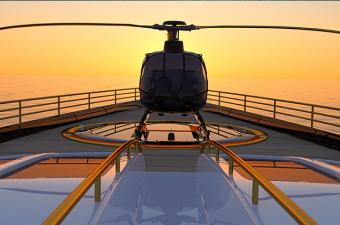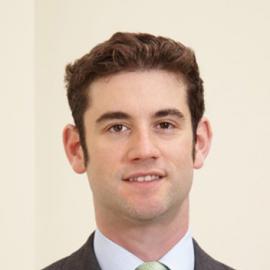
OVERVIEW
Introduction
On 10 May 2017, an AS350 B3 helicopter was landing on the leisure desk of a superyacht, the “Bacarella”, near Bergan Harbour in Norway. The cover of a fuel tank on the yacht was blown off by the down blast of the helicopter as it came into land. Control of the helicopter was lost, which was ditched in the sea but, fortunately, its three occupants survived. The helicopter did not.
Some four years later, the Honourable Justice Adrian Jack handed down judgment in the Claimants’ favour following a (remote) trial in the Commercial Division of High Court of the British Virgin Islands.
This judgment is of interest: (a) on a human level given its participants and facts (which were widely published at the time of the accident); (2) for its examination of factual and expert evidence relating to allegations of contributory negligence in respect of the piloting of the helicopter; and (3) for novel and interesting issues relating to what “in direct connection with the operation of a ship” constitutes for purposes of the Convention on the Limitation of Liability for Maritime Claims 1976.
Facts
The First Claimant company offers helicopter pilot training and is run by Captain Smith (known as “Q”), whom the Judge found to be an honest witness [12] who had heroically saved lives [14]. His achievements were noted by the Judge as including being the first to land a helicopter at the north and south poles, and “managing what frankly is the toe-curling achievement of doing a backflip in a helicopter at 300 feet with the engine turned off.” [12] The Second Claimant is the insurer of the helicopter. The Defendant is a BVI company and registered/owner operator of the yacht.
The accident involving the helicopter took place on 10 May 2017, during a planned flight from Scotland to Bergen. The helicopter was flown by a Chinese businessman known as “CCK”, who effectively owned both the yacht and the helicopter. He was already a qualified pilot (as was Mr Tang, the passenger in the back of the helicopter that day) and had obtained his pilot’s licence for the helicopter in question the day before, having flown with Captain Smith with this and another type before. CCK was accompanied by Captain Smith, his friend and instructor, who was the pilot in command, on the fateful flight on 10 May 2017.
As the helicopter came into land, a fabric fuel cover over a fuel tank billowed in the downdraft. The tank had been installed recently to provide fuel for the helicopter on its tour of the Norwegian fjords. The Master of the Vessel, Captain Stephen Marsh, had also recently ordered a white tarpaulin sheet to cover it. In any event, Captain Smith took control of the helicopter from CCK and aborted the landing by lifting and backing away from the yacht as the cover came loose. As he aborted, the unsecured cover rose rapidly and fouled the main rotor of the helicopter. The vibrations through the controls were such that control was lost. Captain Smith nonetheless managed to ditch the aircraft into the sea without hitting the yacht. He escaped the sinking helicopter and dived under the surface and helped save the lives of CCK and Mr Tang.
The helicopter was a write-off and agreed to be worth in excess of £2 million.
The Claimant alleged the loss of the helicopter was caused solely by the negligence of the Defendant and its servants in failing to secure the cover and giving clearance to land, which was an obvious risk that could easily have been avoided. The Defendant alleged that the accident was in fact caused solely by the negligence of Captain Smith or that such negligence contributed to the loss of the helicopter (floating the figure of 50% for apportionment at trial).
Both parties made extensive use of a video from inside the helicopter (and one from the yacht) during the proceedings as well as expert evidence on piloting and (in the Claimants’ case) a helideck operations expert as well as adducing witness statements from Captain Smith and Captain Marsh.
In the event it was found liable, the Defendant sought to limit its liability for c.£500,000 by relying on s.391 of the BVI Merchant Shipping Act 2001, which gave effect to the 1976 Convention, which limited loss occurring “in direct connection with the operation of the ship”. Needless to say, in the few reported cases on this provision, none had considered the phrase in this context. The Claimants sought to argue, with reference to the case law and documents/facts, that the landing of the helicopter was not an operation of the ship for the regular purposes for which the ship was used or for those envisaged in the 1976 Convention, such as carrying cargo, and submitted it was not related to a maritime function. It was argued that the helideck was a species of aerodrome for these purposes and regulated as such by international aviation conventions.
Issues
The Defendant on the eve of trial admitted primary negligence in relation to failing to secure the cover; and its only factual witness, the Master, said he would not attend trial for alleged medical reasons. This left the issues of: (a) whether the Claimants were guilty of contributory negligence; and (b) whether the Defendant could limit its liability.
In relation to contributory negligence, the Defendant’s allegations included inadequate planning of the flight; allowing CCK to land; hovering for too long over the landing area; Captain Smith not taking control of the helicopter sooner and landing immediately when he saw or should have seen that the cover had broken free.
Decision
The Judge rejected all heads of contributory negligence alleged by the Defendant. [56]. He held that [54]:
(a) Many of the criticisms levelled by the Defendant’s expert (and the report produced by the Accident Investigation Board Norway) were not causative of the accident.
(b) It was entirely appropriate for CCK to land the helicopter especially with a skilled supervisor like Captain Smith present.
(c) The helicopter did not hover for too long, and the Judge was not convinced as to when a hover was too long given the downward force would not carry on indefinitely. In any event, he held that, even if the hover was too long, it had no causative effect. If anything, it would simply have brought forward the moment at which the cover came off. [49-50]
(d) The billowing was not an alarm signal nor was the subsequent inflation of the cover. The cover did not “creep” as suggested by the Defendant’s expert, Captain Packer, and in the AIBN report. The Judge described it as a sudden explosion upwards within less than a quarter of a second. [51, 52]
(e) An emergency landing on the deck at any of the points suggested by the Defendant’s expert was not appropriate. It was much safer to have landed in water than on deck and it avoided the risk of breaking the skids which had no real suspension. It would have risked the tail of the helicopter hitting the yacht, releasing kinetic energy in the tail rotor which, as the Claimant’s expert, Captain Watson said, would have had disastrous consequences.
The Judge made clear that he preferred the evidence Captain Watson over that of Captain Packer, who had never flown (even after being instructed) in the type of helicopter involved in the accident and had not done calculations to support his theories including that Captain Smith should have made an emergency precautionary landing. [33-41] He also accepted that neither CCK nor Captain Smith could see the bottom of the cover to see it flapping at the times alleged by Captain Packer, based on Mr Watson’s calculations. [46-47]
On limitation, the Judge asked himself whether, applying the guidance to interpreting international conventions, the landing was in direct connection with the operation of yacht. [79] He rejected the distinction between the ship operating qua ship and as a species of aerodrome for the purposes of the landing. He saw no difficulty in the ship operating as a ship and potentially as an aerodrome at the same time, even if different regulation applied to the latter function. He held that the yacht was being used for a holiday by helicopter enthusiasts and the landing was in direct connection with that use of the vessel and therefore in direct connection with the operation of the ship.
Conclusion
In addition to the points above, the case is a reminder of the difficulty in establishing contributory negligence based on hindsight for dilemmas created by the defendant where the claimant is making split-second decisions “in the agony of the moment”. It is also an affirmation of the tort “rescuer” cases and of the principle articulated by Devin J (as he then was) in Southport Corporation v Esso Petroleum Co Ltd, namely that: “The safety of human lives belongs to a different scale of values from the safety of property. The two are beyond comparison and the necessity for saving life has at all times been considered a proper ground for inflicting such damage as may be necessary upon another’s property.”
Matthew Reeve, leading Joseph England (instructed by Harneys, BVI) appeared for the successful Claimants


